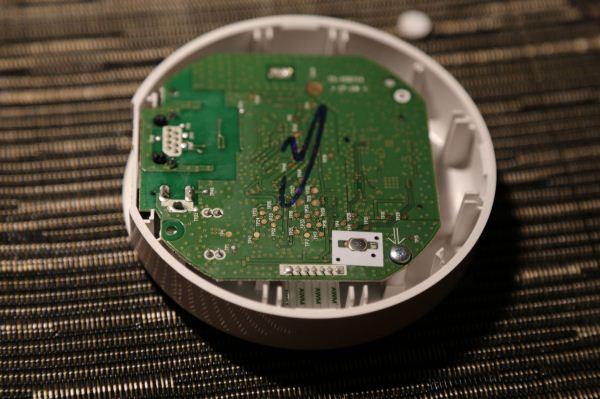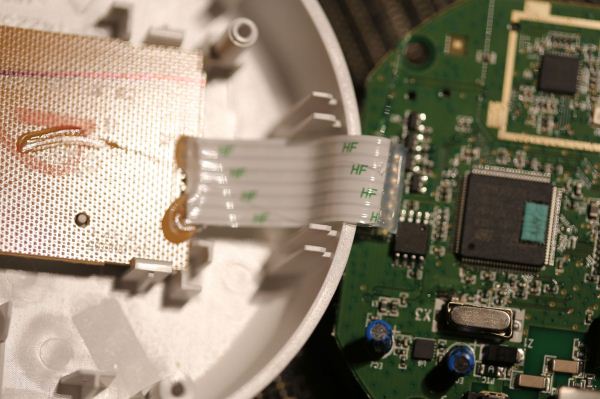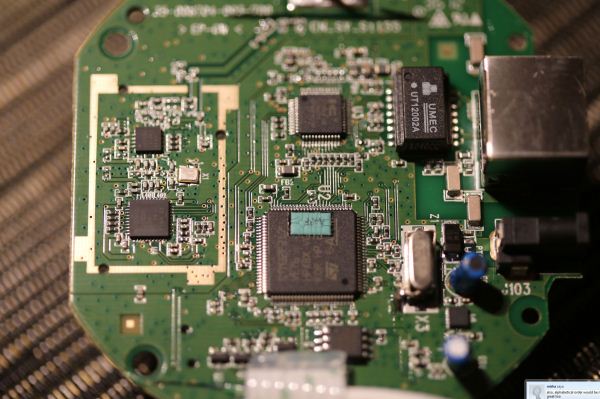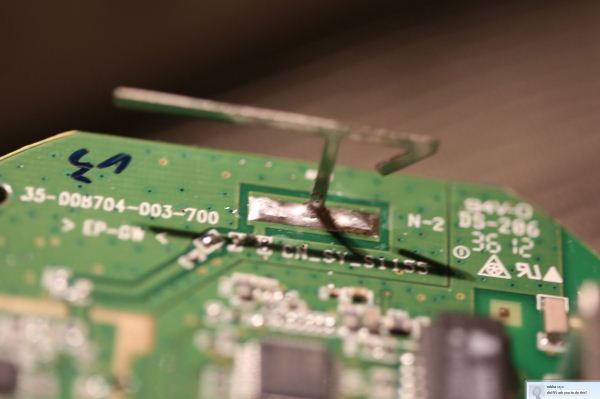Philips Hue: Automated Home Lighting Gets Colorful
by Ashu Joshi on March 1, 2013 12:50 AM EST- Posted in
- Gadgets
- Home Automation
- Philips
- Hue
- Lighting
Teardown and Design
The Hue Bridge has two screws that you need to remove before you can pop off the back. Even with the screws out, popping the back off is tricky—it has an interesting snap-in mechanism. Here’s what the back looks look like; the two white “feet” at the bottom are covering the screws. I used tools from iFixIt to get this open.
Once you open it up, you can see the back side of the PCB, and the snap-in connecter I mentioned earlier.
The PCB is connected to the front of the Bridge using a ribbon connector. This cable provides the power and signals for the LEDs and the Link button.
The main PCB has the two primary components of the Hue Bridge, an ST Microelectronics STM32F217VE Microcontrollerand a Texas Instruments CC2530 ZigBee Controller.
There is also an RF range extender (CC2590) coupled to the CC2530. The STM MCU has an integrated Ethernet controller, but as a whole the design has very few components. It’s clear that the majority of the cost for the Starter Pack is in the bulbs and not in the Bridge. (Based on the total kit price, the Bridge is $20 more than the cost of the three bulbs, though of course that leaves plenty of room for profit margins.) The image below shows the antenna for ZigBee:
I’ll cover the technology behind the Hue Bridge in a moment, but the choice of microcontroller for this design is a clear indication that this is primarily a purpose-built device. That is, it does not have the horsepower to extend to different types of applications due to the limitations of the CPU and the amount of memory. Nonetheless, it is well suited for the function at hand; let’s look at the specifics of the technology behind Hue before we get into a discussion of what it can and cannot do.





















94 Comments
View All Comments
darkcrayon - Wednesday, March 6, 2013 - link
I think the main purpose for this product is the remote control and ability to dynamically adjust the color. "Fun" as it were. The energy savings over incandescent (if anyone still uses those) is more of a bonus. I have a couple of them in floor lamps (with the plastic "bowl" at the top) and they work fine in those, not ultra bright but bright enough for my needs. And again, a lot of fun to be able to bathe my room in blue light leaning back listening to music or what have you.Drizzt321 - Friday, March 1, 2013 - link
Given that I have a Pre3 with webOS, NOBODY has an App for my device. So can I set these up without the app? Is there a web interface that I can use? Or would I have to rely on the hacked HTTP control commands?JarredWalton - Friday, March 1, 2013 - link
If you don't have a smartphone, tablet, or iPod Touch, it appears you'd have to go the hacked support route. Ashu can correct me if I'm wrong. :-)darkcrayon - Wednesday, March 6, 2013 - link
Yeah, you'd have to get a hacked app running on a computer with which you could create a web interface... I did this with my set, there is a handy perl script out called Huepl that lets you control most aspects of the lights from command line commands, so I made a web interface "remote" so i could control the lights easily from any device (the phillips app lets you finely adjust colors and color sets but it isn't as handy and of course it doesn't run natively on a desktop computer).kmmatney - Friday, March 1, 2013 - link
wholly crap, that a lot of lumens...I'm not sure I have any place to put a 2800 Lumen bulb (and it doesn't look like you can dim it) except in my garage. I guess if you only have 1 or 2 light fixtures in a room it would work.Ninhalem - Friday, March 1, 2013 - link
http://arstechnica.com/gadgets/2012/11/in-living-c...Digital Deus - Friday, March 1, 2013 - link
There needs to be an easy way to locally control the light, either at the lamp or on the wall. Having to use an app all the time just to turn on the kitchen light is a non starter.degobah77 - Friday, March 1, 2013 - link
You can still turn on the lights by flipping the switch as you normally would. You just won't be able to dim it or change colors, it acts as a normal bulb at that point. Then as soon as you activate the app, you're in complete control again.Digital Deus - Friday, March 1, 2013 - link
The light always needs to have power. When you turn it off using the switch it's useless as a remote controlled light. The wall or lamp switch needs to be ZigBee.degobah77 - Friday, March 1, 2013 - link
That's what I just said. If you need the immediate gratification of lighting, then you can just flip the switch on and use it as a regular old bulb. If not, just take the 10 seconds to use the app and perform the same action, but with more options. Not sure what the issue is here.